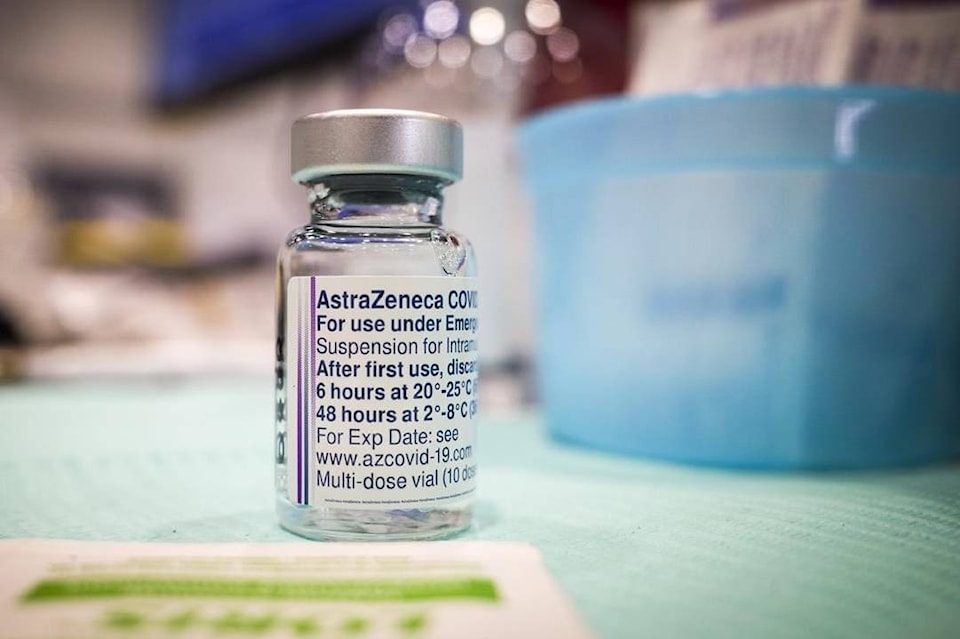Dr. Ben Chan remembers hearing the preliminary reports back in March of blood clots appearing in a handful of European recipients of the Oxford-AstraZeneca COVID-19 vaccine.
The global health expert with the University of Toronto followed the developments closely over ensuing weeks as researchers went from examining what was going on to determining how to diagnose and treat it.
The disorder, characterized by low platelet counts, is now called vaccine-induced thrombotic thrombocytopenia, or VITT. It continues to be an exceedingly rare side effect seen in a small number of recipients of adenovirus vector vaccines.
The science surrounding VITT continues to evolve quickly, and medical professionals have found themselves bombarded with developments, including changing guidance on patient care.
“In my 30-plus years working in the medical system, I don’t think I’ve ever seen such a short time period between discovering something, figuring out how to manage it, and getting the information out into the field,” says Chan.
When a time-sensitive issue like VITT arises, there are multiple ways urgent updates make their way to physicians, nurses and ER staff, note several experts who say the public can feel confident the health system has kept pace with new discoveries.
Dr. Michael Hill, a neuroscience professor at the University of Calgary, says communication varies from province to province and involves multiple avenues, but the goal is to reach hospital staff “very quickly.”
“When you try to get a message out to a huge number of people, you have to do it in a multifaceted way,” says Hill, also director of the stroke unit for the Calgary Stroke Program.
“You can’t just depend on one communication channel.”
He notes a bulletin this week from Alberta Health Services reached approximately 100,000 emergency room doctors, nurses, internists and neurologists via a system-wide email before being posted around hospitals in physical form.
In Ontario, the province’s Science Table recently shared updated guidance that included an extension of the time frame of VITT symptom onset to 4-to-28 days, a change from 4-to-20 days. Chan, who helped author the document, says the update was emailed to various groups.
Meanwhile, over at the Unity Health Network in Toronto, hospital staff use various platforms including email, meetings and WhatsApp group chats to ensure they’re up to date on the latest science, says Dr. Erin O’Connor, deputy chief of the network’s emergency department.
She says social media has also played a role as medical professionals pay closer attention than ever to what global colleagues tweet about their own research or other notable studies.
“It’s fascinating how information has been disseminated in the time of COVID,” says O’Connor. “Everything is changing so rapidly. I mean, some protocols have changed every couple of weeks as we learn more.”
Just this past Friday, an article published in the Canadian Medical Association Journal dismissed initial notions VITT affects mostly younger women and called on doctors and staff to be alert for anyone with possible symptoms.
The article highlighted the case of a 63-year-old man who developed signs 20 days after receiving his AstraZeneca vaccine.
As of Thursday, there were 18 confirmed cases of VITT in Canada — out of more than two million doses of AstraZeneca administered — with 10 more under review. Three Canadians have died.
Most provinces announced last week they’ll no longer offer AstraZeneca as a first-dose option.
Provinces have also issued guidance on symptoms to watch for — including persistent, severe headache; blurred vision; chest, back or abdominal pain; swelling in a limb and multiple bruises — along with information on how to diagnosis and treat the disorder.
At the federal level, Health Canada issues information on vaccine safety concerns, and along with the Public Health Agency of Canada, has put together “a network of clotting (and) hematology specialists across the country,” available for consultations, says chief medical adviser Dr. Supriya Sharma.
Sharma adds it’s up to provincial and territorial governments to inform front-line health professionals who could see potential VITT cases.
Keeping up with an ever-evolving scientific landscape is part of a doctor’s job.
Chan notes Canadian doctors must earn continuing education credits to remain certified with their specialty societies, with each credit roughly equivalent to an hour of lectures, reading or group study. The minimum is 50 credits per year for family doctors and 80 for specialists.
While VITT can represent challenges as a novel disorder, blood clots themselves are not new.
O’Connor says triage nurses — a patient’s first point of contact in an emergency room — have been trained to spot potential clot symptoms long before VITT emerged.
Hill says the difference now is they’ll ask patients whether they’ve received the AstraZeneca vaccine when presenting with possible VITT signs.
Concerns arose last week when a woman with VITT symptoms was reportedly turned away from an emergency room in Edmonton. The woman went to another hospital, where a CT scan revealed a blood clot, and she died shortly after.
Chan, who didn’t know the specific context of the woman’s case, says human error does sometimes happen in medicine. But, he adds the public should feel confident health professionals know what to look for.
“It’s important that patients who have symptoms like severe headache or bleeding after vaccination seek care immediately and ask that VITT be ruled out,” he says.
— With files from Mia Rabson in Ottawa
Melissa Couto Zuber, The Canadian Press
